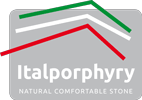Kerbs
Porphyry Kerbstone are used for the borders of pavements, flower bed, steps, sett and for the outlining of areas and paving.They are produced in block form with a head (the upper face) that ca be: natural suface, sawn, flamed, bush hammered or sand. Porphyry Kerbstone have two sides, one of which is visible and can be sawn or natural quarry. Yhe visible edges are usually chamfered for a few millimeters so as not to leave sharp edges. The lenght of porphyry kerbs is free and minimum 40cm. Sometimes smaller ones are required to create curves for particular features.
Technical data sheet porphyry Kerbs
| KERBS | |||||
|---|---|---|---|---|---|
| Petrographic name | Rhyolitic ignimbrite | ||||
| Colour | Non-dominant variable-colour grades: grey, red, red-violet, rust or mixed colours | ||||
| Main processing | Obtained from stratified material with natural quarry plane, of variable thickness, or by block-sawing and subsequent surface processing | ||||
| TYPE | HEAD THICKNESS (mm) |
HEICHT (mm) |
WEIGHT (Kg/m²) |
JOINTS | SUGGESTED APPLICATION |
| Split | 50, 60, 70, 80, 90, 100, 120 | from 200 to 250 | from 25 to 85 | Split | Flowerbed borders |
| Natural quarry top and sawn sides | 80, 100, 120, 150 | from 200 to 250 | from 45 to 120 | Split, sawn | Pavement edges, Level changes, wide steps, Roundabout marking |
| Sawn top, quarry face sides | 50, 60, 70, 80, 90, 100, 120, 150 | from 200 to 250 | from 25 to 120 | Split, sawn | Pavement edges, Level changes, Wide steps |
| Shot-blasted or flamed top | 50, 60, 70, 80, 90, 100, 120, 150 | from 200 to 250 | from 25 to 120 | Split, sawn | Pavement edges, Level changes, Wide steps |
| All sides sawn and/or processed | 50, 60, 70, 80, 90, 100, 120, 150 | from 200 to 250 | from 25 to 120 | Sawn | Pavement edges, Flowerbed borders with double exposed edge, Kerbs as risers |
